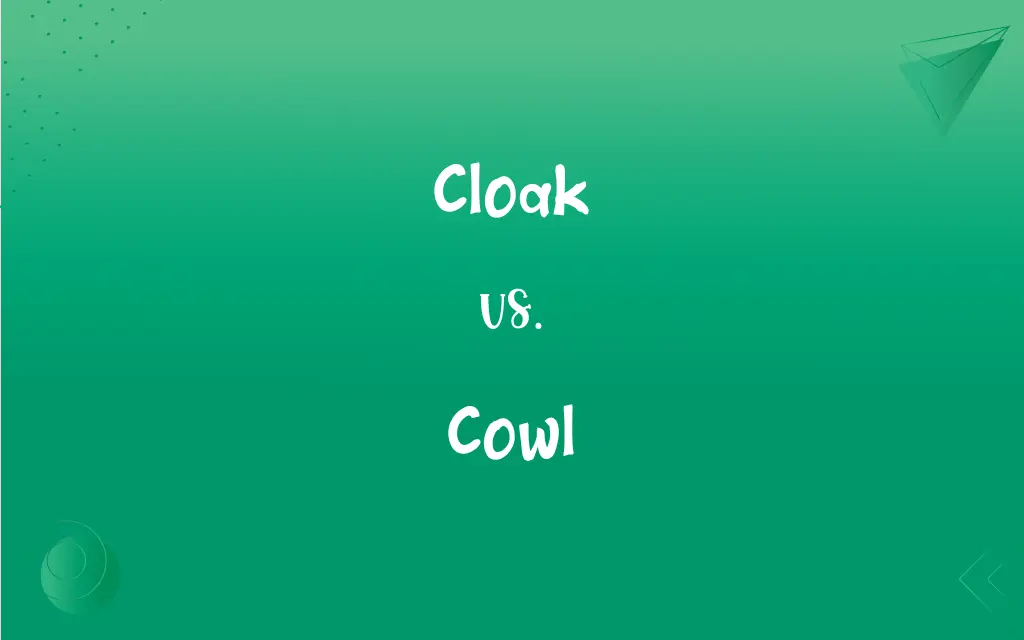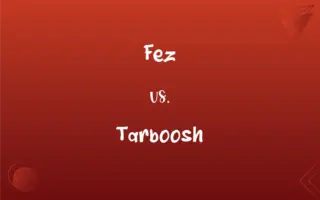Cloak vs. Cowl: What's the Difference?
By Janet White || Updated on May 22, 2024
A cloak is a loose, sleeveless outer garment that covers the body, while a cowl is a hooded garment or a hood itself that covers the head and shoulders. Cloaks offer full-body coverage, whereas cowls focus on head and shoulder protection.

Key Differences
A cloak is a long, loose outer garment designed to cover the wearer from the shoulders down, often reaching the ankles. Typically, cloaks are fastened at the neck or shoulder and do not have sleeves, providing an elegant, flowing appearance. A cowl, on the other hand, is a garment that covers the head and shoulders, often including a hood. The term can refer to either the hood itself or the entire hooded garment. Cowls are commonly associated with monastic clothing, where they serve both a practical purpose of warmth and a symbolic purpose of humility.
Cloaks are usually worn over other clothing and can be made from various materials, such as wool or velvet, suitable for different climates and social contexts. In contrast, cowls are integral to the attire they are part of, particularly in religious or medieval contexts, and are often made from simple, durable fabrics.
While cloaks are versatile in fashion and function, being used in both historical and fantasy settings for their dramatic flair, cowls are more specific in their use. They are often seen in religious orders, historical reenactments, and some fantasy genres, emphasizing their role in providing head and shoulder coverage.
Cloaks typically feature a clasp or tie at the neck, allowing them to drape over the body without restriction, whereas cowls may be attached to other garments or standalone hoods that slip over the head. This difference in design highlights the cloak's purpose of body coverage and the cowl's focus on head and shoulder protection.
Cloaks can come in various lengths and styles, from short capes to full-length robes, adapting to the wearer's needs. Cowls, however, are generally more uniform in appearance, prioritizing the practical need for warmth and modesty over aesthetic variety.
ADVERTISEMENT
Comparison Chart
Coverage
Body (shoulders down)
Head and shoulders
Design
Sleeveless, fastened at neck
Hooded, can be part of a garment or standalone
Historical Use
Protection from elements, fashion
Monastic attire, head covering
Material
Various (wool, velvet, etc.)
Simple, durable fabrics
Attachment
Clasp or tie at neck
Often integrated or standalone
ADVERTISEMENT
Cloak and Cowl Definitions
Cloak
A loose outer garment that covers the shoulders and body, typically long.
The hero wore a flowing cloak as he entered the castle.
Cowl
A hooded garment covering the head and shoulders.
The monk's cowl concealed his face in shadows.
Cloak
A sleeveless garment that drapes over the wearer, often for warmth.
She pulled her cloak tighter against the cold wind.
Cowl
A hood itself, often part of a larger garment.
He pulled the cowl over his head to stay warm.
Cloak
An item of clothing that offers full-body coverage.
The magician's cloak added an air of mystery to his performance.
Cowl
A part of monastic clothing that includes a hood.
The cowl of the habit was worn by monks in the abbey.
Cloak
A garment used historically for both practical and decorative purposes.
Medieval knights often wore cloaks over their armor.
Cowl
A covering for the head and shoulders, typically loose.
The cowl protected her from the wind as she walked.
Cloak
A long, loose outer garment, usually having a hood and no sleeves.
Cowl
A hooded cloak or robe, particularly in religious contexts.
The friar's cowl was simple but functional.
Cloak
Something that covers or conceals
A cloak of secrecy.
Cowl
The hood or hooded robe worn especially by a monk.
Cloak
To cover or conceal with a cloak or something that acts like a cloak
Mist that cloaks the mountains.
Cowl
A cowl neck.
Cloak
A long outer garment worn over the shoulders covering the back; a cape, often with a hood.
Cowl
A hood-shaped covering used to increase the draft of a chimney.
Cloak
A blanket-like covering, often metaphorical.
Night hid her movements with its cloak of darkness.
Cowl
The top portion of the front part of an automobile body, supporting the windshield and dashboard.
Cloak
(figurative) That which conceals; a disguise or pretext.
RQ:South Twelve Sermons
Cowl
The cowling on an aircraft.
Cloak
(Internet) A text replacement for an IRC user's hostname or IP address, making the user less identifiable.
Cowl
To cover with or as if with a cowl.
Cloak
(transitive) To cover as with a cloak.
Cowl
A monk's hood that can be pulled forward to cover the face; a robe with such a hood attached to it.
Cloak
To cover up, hide or conceal.
Cowl
A mask that covers the majority of the head.
Cloak
To render or become invisible via futuristic technology.
The ship cloaked before entering the enemy sector of space.
Cowl
A thin protective covering over all or part of an engine; also cowling.
Cloak
A loose outer garment, extending from the neck downwards, and commonly without sleeves. It is longer than a cape, and is worn both by men and by women.
Cowl
A usually hood-shaped covering used to increase the draft of a chimney and prevent backflow.
Cloak
That which conceals; a disguise or pretext; an excuse; a fair pretense; a mask; a cover.
No man is esteemed any ways considerable for policy who wears religion otherwise than as a cloak.
Cowl
(nautical) A ship's ventilator with a bell-shaped top which can be swivelled to catch the wind and force it below.
Cloak
To cover with, or as with, a cloak; hence, to hide or conceal.
Now glooming sadly, so to cloak her matter.
Cowl
(nautical) A vertical projection of a ship's funnel that directs the smoke away from the bridge.
Cloak
Anything that covers or conceals
Cowl
(metonymy) A monk.
Cloak
A loose outer garment
Cowl
A vessel carried on a pole, a soe.
Cloak
Hide under a false appearance;
He masked his disappointment
Cowl
A caul the amnion which encloses the foetus before birth, especially that part of it which sometimes shrouds a baby’s head at birth.
Cloak
A covering that provides protection from weather.
The travelers used their cloaks to shield themselves from the rain.
Cowl
To cover with, or as if with, a cowl (hood).
Cowl
To wrap or form (something made of fabric) like a cowl.
Cowl
(transitive) To make a monk of (a person).
Cowl
(Yorkshire) To scrape together
Cowl
A monk's hood; - usually attached to the gown. The name was also applied to the hood and garment together.
What differ more, you cry, than crown and cowl?
Cowl
A cowl-shaped cap, commonly turning with the wind, used to improve the draft of a chimney, ventilating shaft, etc.
Cowl
A wire cap for the smokestack of a locomotive.
Cowl
A removable metal covering for an aircraft engine, providing streamlining to minimize wind resistance; - also called cowling.
Cowl
A covering for a chimney or other ventilating shaft functioning to increase the draft.
Cowl
A vessel carried on a pole between two persons, for conveyance of water.
Cowl
Protective covering consisting of a metal part that covers the engine;
There are powerful engines under the hoods of new cars
The mechanic removed the cowling in order to repair the plane's engine
Cowl
A loose hood or hooded robe (as worn by a monk)
Cowl
Cover with or as with a cowl;
Cowl the boys and veil the girls
FAQs
What is a cowl?
A cowl is a hooded garment or hood that covers the head and shoulders.
How does a cloak differ from a cowl?
A cloak covers the body from the shoulders down, while a cowl covers the head and shoulders.
What is a cloak?
A cloak is a loose, sleeveless outer garment that covers the shoulders and body.
Are cloaks still used today?
Yes, cloaks are used in fashion, costume, and some ceremonial contexts.
Is a cowl always part of a garment?
Not always; a cowl can be a standalone hood or part of a larger garment.
Are cloaks used in modern fashion?
Yes, cloaks are popular in fashion for their dramatic and elegant appearance.
Where are cowls typically seen?
Cowls are commonly seen in monastic attire and historical reenactments.
What materials are cloaks made from?
Cloaks can be made from wool, velvet, and other materials.
Do cowls have a specific design?
Yes, cowls typically have a hood and cover the head and shoulders, often integrated into a garment.
How are cloaks fastened?
Cloaks are usually fastened with a clasp or tie at the neck.
What is a modern use of a cowl?
Modern uses of cowls include fashion accessories and cosplay.
What is the historical significance of a cowl?
Cowls have been significant in religious and monastic settings for modesty and warmth.
What is the purpose of a cowl in monastic clothing?
The cowl serves to provide warmth and symbolize humility.
Are cloaks and cowls interchangeable?
No, cloaks and cowls serve different purposes and are not interchangeable.
Can a cloak have a hood?
Yes, some cloaks include a hood, but they are primarily for body coverage.
What occasions are cloaks worn?
Cloaks are worn in historical reenactments, ceremonies, and as part of costumes.
Are cowls worn outside of religious contexts?
Yes, cowls can be part of medieval costumes, fantasy outfits, and some modern fashions.
Can a cloak be part of a uniform?
Yes, cloaks have been part of military and ceremonial uniforms historically.
Can a cowl be decorative?
While primarily functional, some cowls may have decorative elements in certain contexts.
Do cowls offer full-body coverage?
No, cowls specifically cover the head and shoulders.
About Author
Written by
Janet WhiteJanet White has been an esteemed writer and blogger for Difference Wiki. Holding a Master's degree in Science and Medical Journalism from the prestigious Boston University, she has consistently demonstrated her expertise and passion for her field. When she's not immersed in her work, Janet relishes her time exercising, delving into a good book, and cherishing moments with friends and family.































































